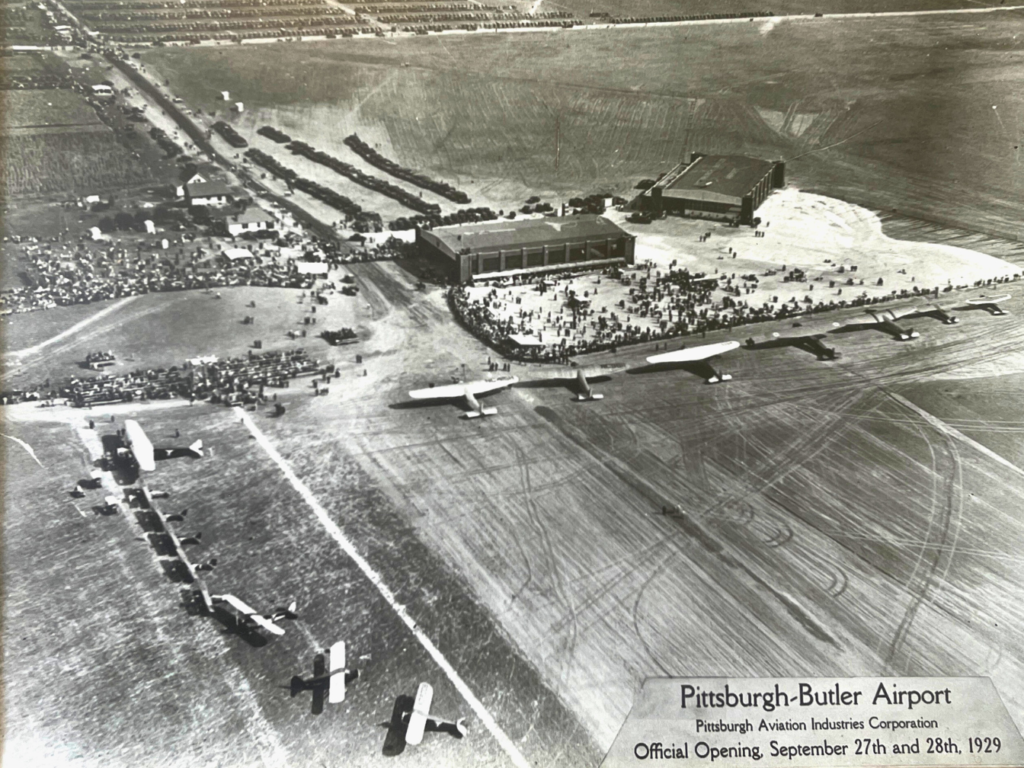September 1929 – The stock market crashed, the Cubs win the National League Pennant, and KBTP was officially dedicated Pittsburgh Butler Airport. The future of Pittsburgh-Butler Regional Airport started with little fanfare on September 27 & 28, 1929.

In early 1909, Roy Knabenshu, in a one-man dirigible, was the first to fly into the new airport. Roy previously worked with the Wright Brothers in their Dayton facility. After the Wright Brothers completed their second flight at Kitty Hawk, a fixed wing flight took place at the airport. This flight followed the same path as Roy did, Bantam Avenue to the courthouse and back.
Additionally in the early 1930’s, William Graham purchased the airport after an argument over the storage bill ensued between him and the Pittsburgh Aviation Industries Corporation. William didn’t possess much aviation knowledge, as he was just a general aviation private pilot, so he contacted Kenneth Scholter. Now named Butler-Graham Airport, Scholter managed the daily running of the operations.
On May 20, 1932, Amelia Earhart flew her Lockheed Vega to the airport. As written in the “Not Just a Hero, But a Legend” by Joyce Echevaria, Amelia heard about Kenneth Scholter. He was known as an expert mechanic and flight instructor. Scholter installed long range fuel tanks for her. She also received her instrument training from Kenny, as he was known, before flying solo across the Atlantic.
C.G. Taylor, struggling with his small up-start company, opened operations at the airport in the historic C-1 hangar where High Flight Academy currently resides. Taylor designed and built the now famous Taylorcraft with the help of Kenneth Scholter.
Big things started happening here at the airport in December of 1940. William J Graham was awarded a five-million-dollar Government Contract to operate “one of the largest and most important flying schools in the United States” near Atlanta, Georgia (The Pittsburgh Press, December 15, 1940). He began expanding the current flight school at the Butler airport by hiring instructors and bought several airplanes. After creating a training program that he took to the Civil Aeronautics Authority. They did not give him immediate answers, so he moved forward with free ground classes. These classes were taught by several instructors including Kenneth Scholter (The Pittsburgh Press, December 15, 1940). Training courses for the Civil Aviation Authority were later expanded to other locations such as Meadville, Oil City, Bridgeville, and Natrona Heights airports.
During the years of WWII, 1935-1945, the airport served as a cadet primary training facility contracted with the Army Air Corps headed by the Civil Aeronautics Authority War Training Service (CAA-WTS). The cadets resided at the nearby Slippery Rock and Grove City colleges.
In 1949, the Butler County Airport Authority is formed. The authority purchased the runway from John Graham. Grants funded paving of the runway in 1950.
William’s son, John Graham, ran Graham Aviation from 1969-1980. He then sold the airport to the authority and became CEO of the Pittsburgh Institute of Aeronautics (PIA) at Allegheny County Airport. After the sale, the authority renamed the airport to the well-known name of The Butler-Pittsburgh Airport and K.W. Scholter Field to honor the achievements of Kenneth Scholter. Later, the name changed once again to its current name of The Butler-Pittsburgh Regional Airport (KBTP).
We’ll present more information and a history of K.W. Scholter in our next newsletter. In writing this article, The Butler-Pittsburgh Regional Airport (KBTP) website as well as The Pittsburgh Press archives were excellent references. The full December 15, 1940, Pittsburgh Press article may be found online with a brief Google search. It is in the twelve-fourth shuttered newspapers archives.
